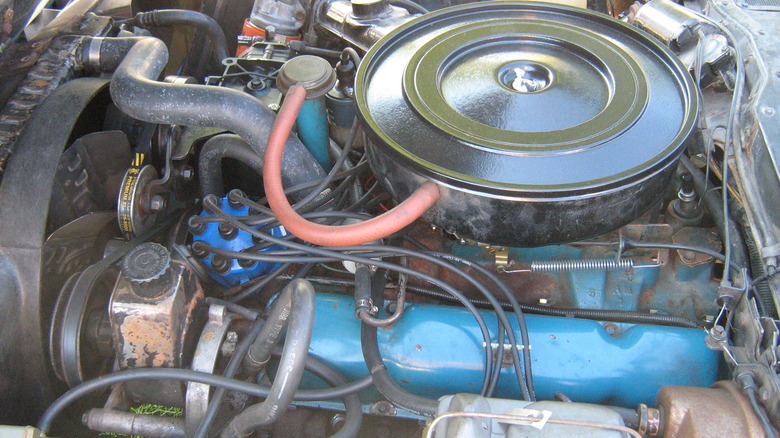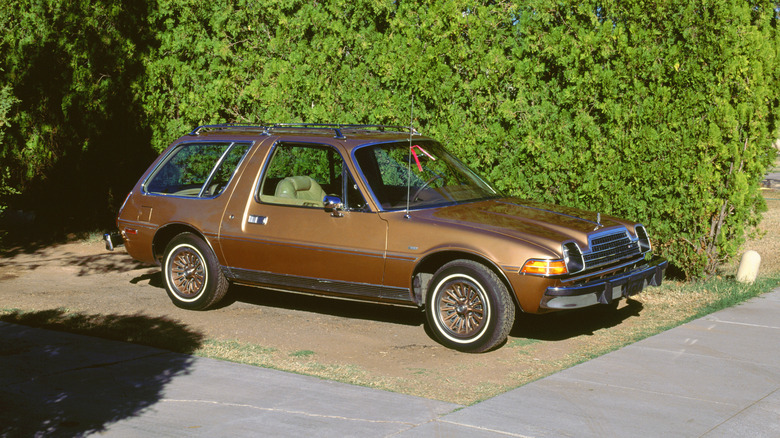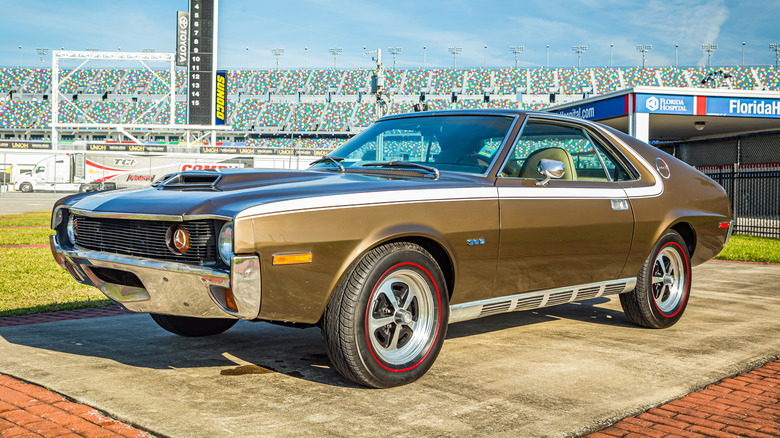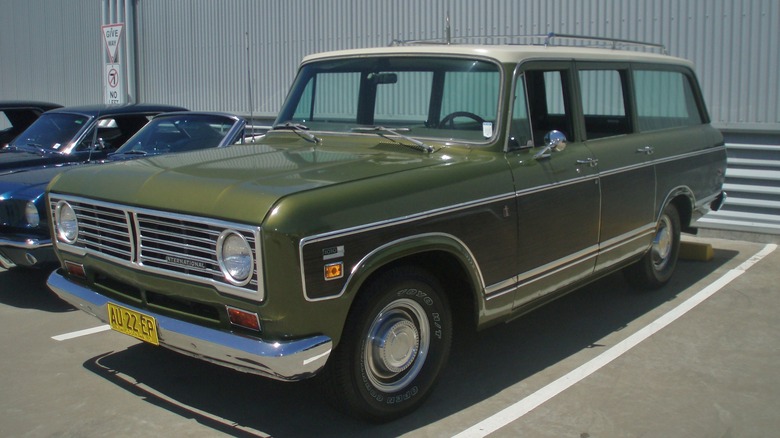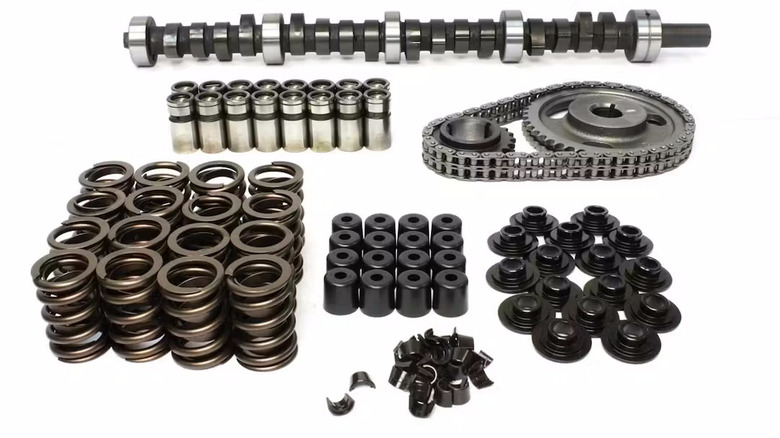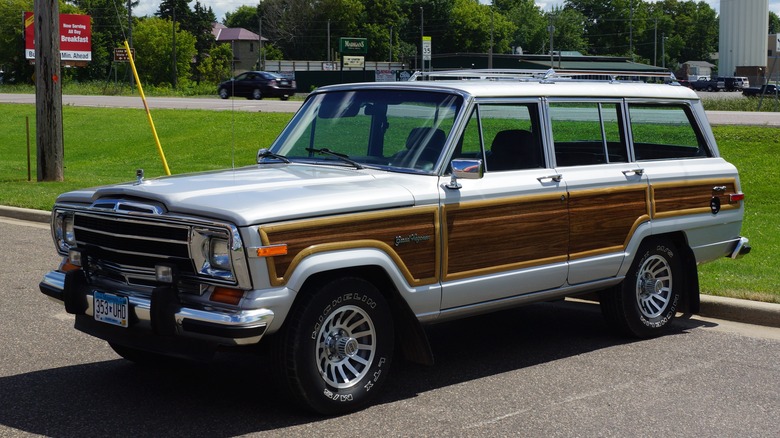Everything To Know About The AMC 304, 360, And 401 Engines
AMC, or American Motors Corporation, may not have ever elevated itself to the level of the United States' "Big Three" automakers. However, it still made several legendary AMC muscle cars and built some of the best and most enduring Jeep models in that brand's long history. Beyond those two accomplishments, who can forget the inimitable Pacer and much-maligned Gremlin, two of the most uniquely designed cars of the 1970s? The Pacer was dubbed the "Flying Fishbowl" by Car and Driver and the Gremlin was designed on a barf bag, but both models had their moments in the sun, thanks in part to the reliable eight-cylinder engines they shared with their distant muscle car and Jeep cousins.
AMC's original in-house V8s were born out of desperation when a planned partnership with Studebaker-Packard fell apart in the mid-'50s. The first generation of AMC eight-cylinder engines were made between 1956 and 1966 in 250, 287, and 327 cubic-inch displacements.
A second generation was produced between 1966 and 1970 in 290, 343, and 390 cubic-inch versions, but when AMC bought the Jeep brand from Kaiser in 1970, it introduced a new lineup of V8s. This third-series AMC V8 engine was available in 304, 360, and 401 cubic-inch sizes. Let's take a closer look at this family of long-lasting and powerful motors.
[Featured Image by CZMarlin via Wikimedia Commons| Cropped and scaled| Public domain]
The 304 was used between 1971 and 1981
The first AMC vehicles to be graced with the new family of V8s were the Jeep J series pickup and SJ Wagoneer, both of which got the 304 cubic-inch motor beginning in 1971. The 304 spread to the CJ series the next year, although 1972 was also the last year it was used in Jeep pickup and Wagoneer models. It was also used in 1974 and 1975 AMC Gremlin X Rallye and Hornet Rallye X cars, as well as the 1978 and 1979 Pacer.
The earliest iterations of the 304 were so powerful that the frame of the CJ-5 had to be upgraded to prevent cracking. The long and choking arm of smog regulations that took effect as the '70s wore on gradually sapped the power from this engine, and by the time it was dropped from the AMC option list in 1981, it could barely keep up with the 258 cubic-inch straight six. According to Jeep Tech, the 1971 304 put out 210 horsepower and 300 pound-feet of torque, but by 1980 those numbers had plunged to 125 horsepower and 220 pound-feet.
The 360 was the longest-lived of the third-generation AMC V8s
The 360 cubic-inch V8 first appeared in the 1970 AMX, Javelin, and Rebel. It was added to the Jeep J series the next year along with the AMC Matador, where it remained as an option through 1978. The 360 was also chosen for the aptly badged 1971 Hornet S/C 360, which was available with a $199 "Go" package that included a four-barrel carburetor that boosted output to 285 horsepower. Garden-variety Hornets could be purchased with the 360 through 1974.
The 360 lived on under the hoods of Grand Wagoneers until 1991, making it the longest-lived AMC engine ever. It was also used in the standard SJ Wagoneer between 1976 and 1983, the J series from 1981 through Chrysler's acquisition of Jeep in 1987, and in the 1974 Bricklin SV-1 sports coupe.
AMC sold the 401 to International Harvester for two years
When AMC transitioned from the second to third generation V8 series in 1970, it kept the basic second-gen block design and built the new motors with higher decks for a longer stroke and higher capacity. This essentially turned the 290 into the 304 and the 343 into the 360. The 390 remained at that displacement in 1970, but the following year it got a wider bore and grew into the 401. That same year it appeared in the Matador, Javelin, and Ambassador.
In 1974, the 401 made its way into the Jeep line under the hoods of Cherokees, Wagoneers, and J series trucks. It was also sold to International Harvester in 1973 and '74 for use in Travelall SUVs and Light Line pickup trucks. According to Muscle Car Club, the 401's compression ratio ranged from 8.25:1 to 10.2:1 and power output could be anywhere from 235 to 335 horsepower depending on the carburetor model and exhaust configuration. The 401 only stayed in production through 1978, but it remains popular today with Jeep loyalists thanks in part to the availability of fuel injection, camshaft, and high-compression piston upgrades.
[Featured Image by sv1ambo via Wikimedia Commons| Cropped and scaled|CC-By 2.0]
Some parts are interchangeable between the three motors
The 304, 360, and 401 cubic-inch AMC V8s all had the same external dimensions. The different displacements were achieved with variations in bore and stroke. These engines are externally balanced via the flywheel or flexplate, though, so these components cannot be exchanged between the three engines. The cylinder heads are generally swappable among the three motors, although valve components differ and the 401 used a forged crankshaft and connecting rods instead of the 304 and 360's cast iron rods and crank.
Beginning in 1974, all three engines got bridged aluminum rocker arms, making the later iterations less suited to high-horsepower upgrades. Fortunately for performance-minded AMC aficionados, there is tremendous aftermarket support for these engines from trusted suppliers like Speedway Motors and Summit Racing.
As for internal dimensions, the 304 and 360 share the exact same stroke of 3.44 inches, with the 360's bore of 4.08 inches providing it the extra volume compared to the 304's bore of 3.75 inches.
AMC V8s are known to last 300,000 miles or more
The internal differences between the 304, 360, and 401 cubic-inch AMC V8 engines are utterly moot for most modern gearheads, who will likely want to tear down and rebuild any half-century-old engine they acquire. Before you reach for your impact wrench and start yanking heads and shafts, though, consider the longevity of these engines.
Many owners of V8-powered Jeeps report getting close to or beyond 300,000 miles on their original motors, and the dearth of AMC models with high numbers on the odometer may be more the fault of hard-driving owners than any shortcoming of the powertrains themselves. Were it not for the success and popularity of the equally durable 258 and 242 straight six engines that replaced the 304, 360, and 401 cubic-inch V8s, AMC might have kept the larger motors in place up until it was bought by Chrysler in 1987.
Chrysler's purchase was primarily motivated by interest in the Jeep brand, but AMC's new owner also kept the Eagle nameplate alive for another decade or so. The cars it released with that badging were largely underpowered disappointments, and Chrysler's smartest move after the AMC buyout might have been to keep the 360 under the hood of the Grand Wagoneer and Grand Cherokee through 1991.
[Featured Image by Greg Gjerdingen via Wikimedia Commons | Cropped and scaled | CC-By 2.0]
